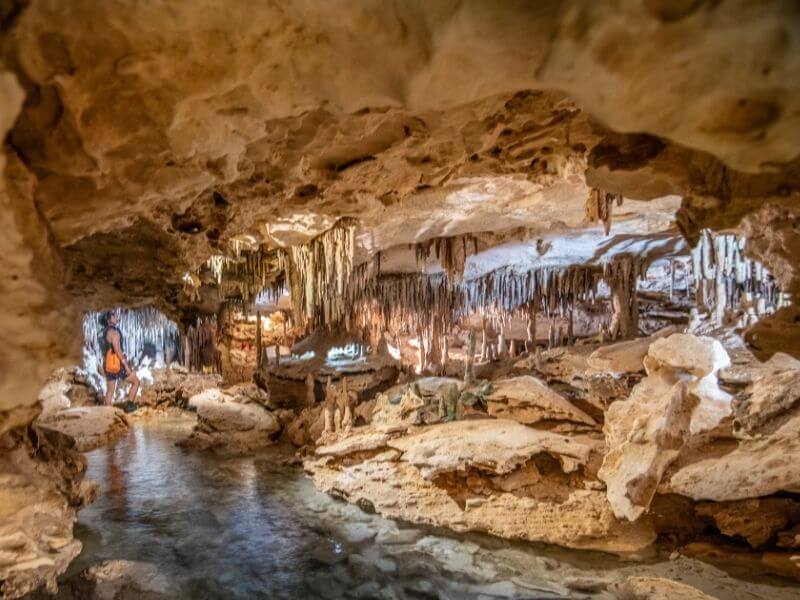Secretly hidden among the jungles of the Yucatan Peninsula, the cenotes in Mexico were once considered a portal between the underworld and us. Today, it is a bit more complex than that.
We were driving for almost an hour through the dense jungle and beside a couple of signs indicating we are in the right direction, me and my friends we were completely lost. We were on our way to the underwater cave of Aktun-Chen, one of the most fascinating cenotes in Mexico and according to National Geographic, “the best underground walk in the Americas”. Once there, the wait did not disappoint. We walked around the most breathtaking natural pond located inside a cathedral made of surreal rock formations, stalactites and stalagmites – all of this surrounded by a forest full of fruit bats, colorful birds, spider monkeys and one or another wild hog.
This is also one of the very few cenotes where swimming is not allowed, as a very fragile layer of calcium carbonate sediment will disappear when in contact with body oils and destroy the beauty of this natural sanctuary.
But, Aktun-Chen is only one of the 6.000 cenotes in Yucatan, and while for this one you definitely need a car to visit it, some others are way easier to access, while others are still unexplored.
Read more: Hiking the Pacaya volcano in Guatemala

The birth of the Yucatan’s hidden gems
The Yucatan peninsula has one of the most interesting geological compositions worldwide. It is characterized by its limestone bedrock, the largest underground river in the planet, and constant mineral sedimentation – conditions that after millions of years built an underwater karst landscape shaped by nature like anywhere in the world.
However, cenotes are not the underground rivers under these conditions, but sinkholes with natural pools. This happens once the surrounding bedrock destabilizes so much that it collapses and reveal the cave underneath.
Furthermore, as the length, size, and depth of the underground rivers change all along the peninsula, once a cenote is formed, the only way to know how it looks like is by exploring it deep underwater.
Read more: Exploring the Underwater Museum of Art (MUSA) in Mexico
Read more: Meet the Guatemalan god living in a wooden body
Read more: Explore the volcano route of Nicaragua

A way to communicate with God
“Cenotes are considered by Mayan culture to be the gateway to the Xibalba, a version of the underworld”, said one of the tour guides at the cenote of Kantun Chi, “Some ceremonies even had human sacrifices to please the Gods”, he concluded.
Archeologists have also found in these places a way to learn more about the behavior of the Mayan, as some cenotes have been the source of many discoveries such as jade, gold, and human remains. Some experts also insist that some cenotes were just for sacrifices, while others consider the cenotes a transit zone to the Xibalba and a source of fresh water for the Mayan communities.
Read more: Tips for renting a car in Mexico
Read more: Islands of the Yucatan Peninsula – Isla Mujeres or Cozumel?
Read more: Yaxha and Tikal – Visiting the centers of Maya culture

What’s the importance of cenotes today?
Nowadays, cenotes got a lot of popularity through social media and have become large magnets for tourists from all over the world. Its beauty and easy access attract thousands of visitors every day and visiting the Yucatan Peninsula but forgetting to explore at least one cenote would be missing something very special.
Still, I think no matter why we visit a cenote, it is very important to not forget the bigger picture. Cenotes should not be considered only a tourist attraction, but as a spot for connecting culture, science, nature and society.
For us travelers is a marvel of nature and a place for relaxation. But for scientists and experts is an access point to vast networks of largely unexplored cave systems. Simultaneously, for the Mayan, cenotes were their only connecting point between life and death, and for the communities living in Yucatan, it was (and still is) one of the most important water sources available.
Note: Visiting a cenote in Mexico can cost anything between 5 USD up to 80 USD
Read more: How to plan a road trip at the Yucatan Peninsula
Read more: Which are the most beautiful waterfalls of Central America
Read more: How to visit Pulhapanzak – Honduras’ mighty waterfalls

Insider Tip:
Bookaway is the right platform to get your tickets online and fast if you want to travel around the country using public transportation. No waiting lines at bus stations or asking around which bus goes where.






